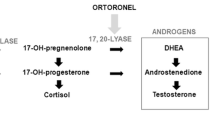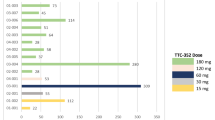Abstract
Preclinical data suggest that medroxyprogesterone acetate (MPA) has both anti-metastatic and anti-angiogenic activity in the absence of hormone receptors (HR). This phase II trial assessed the activity of MPA alone or in combination with low-dose chemotherapy in patients with metastatic HR-negative breast cancer. Postmenopausal women with HR-negative disease were eligible if they had not received more than 3 chemotherapy regimens for metastatic disease. All patients were treated with MPA 1,000–1,500 mg/day orally; patients in cohort two also received low-dose oral cyclophosphamide and methotrexate (ldCM, 50 mg/day and 2.5 mg twice daily on Days 1 and 2 each week). Tissue and circulating biomarkers were assessed serially. The primary endpoint was clinical benefit response defined as objective response or stable disease >6 months. Thirty patients were enrolled (14 MPA monotherapy; 16 MPA + ldCM); median age was 55 (35–80); nearly all had visceral involvement. Despite dose escalation in 90 % of patients, only 17 (57 %) patients ever achieved MPA trough concentrations >50 ng/ml. One patient developed grade 4 renal failure in the setting of rapid disease progression and dehydration. There were no objective responses. One patient in each cohort (~7 %) had stable disease for > 6 months. Skin Nm23 expression increased after 4 weeks of MPA + ldCM, but there were no significant changes in TSP-1, PAI-1 antigen, or PAI-1 activity. MPA had limited activity and does not warrant further development in patients with HR-negative advanced breast cancer. Poor bioavailability limited exposure despite dose escalation.


Similar content being viewed by others
References
Hanahan D, Weinberg RA (2000) The hallmarks of cancer. Cell 100(1):57–70
Sledge GW Jr, Miller KD (2003) Exploiting the hallmarks of cancer: the future conquest of breast cancer. Eur J Cancer 39(12):1668–1675
Steeg PS, Bevilacqua G, Pozzatti R, Liotta LA, Sobel ME (1988) Altered expression of NM23, a gene associated with low tumor metastatic potential, during adenovirus 2 Ela inhibition of experimental metastasis. Cancer Res 48(22):6550–6554
Ouatas T, Halverson D, Steeg P (2003) Dexamethasone and medroxyprogesterone acetate elevate Nm23-H1 metastasis suppressor expression in metastatic human breast carcinoma cells: New uses for old compounds. Clin Cancer Res 9:3763–3772
Yoshida B, Sokoloff M, Welch D, Rinker-Schaeffer C (2000) Metastasis-suppressor genes: a review and perspective on an emerging field. J Natl Cancer Inst 92:1717–1730
Leone A, Flatow U, King C, Sandeen M, Margulies I, Liotta L, Steeg P (1991) Reduced tumor incidence, metastatic potential, and cytokine responsiveness of nm23-transfected melanoma cells. Cell 65:25–35
Leone A, Flatow U, VanHoutte K, Steeg P (1993) Transfection of human nm23-H1 into the human MDA-MB-435 breast carcinoma cell line: effects on tumor metastatic potential, colonization, and enzymatic activity. Oncogene 8:2325–2333
Cropp C, Lidereau R, Leone A, Liscia D, Cappa A, Campbell G, Barker E, Doussal V, Steeg P, Callahan R et al (1994) NME1 protein expression and loss of heterozygosity mutations in primary human breast tumors. J Natl Cancer Inst 86:1167–1169
Ouatas T, Clare S, Hartsough M, DeLaRosa A, Steeg P (2002) MMTV-associated transcription factor binding sites increase nm23-H1 metastasis suppressor gene expression in human breast carcinoma cell lines. Clin Exp Metast 19:35–42
Palmieri D, Halverson D, Ouatas T, Salerno M, Johnson J, Figg W, Hollingshead M, Hursting S, Berigan D, Steinberg S et al (2005) Medroxyprogesterone acetate elevation of Nm23-H1 metastasis suppressor expression in hormone receptor—negative breast cancer. J Natl Cancer Inst 97:632–642
Van Veelen H, Willemse P, Tjabbes T et al (1986) Oral high-dose medroxyprogesterone acetate versus tamoxifen. Cancer 58:7–13
Nishimura R, Nagao K, Matsuda M, Baba K, Matsuoka Y, Yamashita H, Fukuda M, Higuchi A, Ikeda K (1997) Predictive value of serum medroxyprogesterone acetate concentration for response or recurrent breast cancer. Eur J Cancer 33(9):1407–1412
Tashiro H, Nomura Y (1995) Mitomycin C, methotrexate, and vincristine with medroxyprogesterone acetate or prednisolone for doxorubicin resistant advanced breast cancer–a randomized control study. Anticancer Res 15(5B):2229–2237
Koyama H, Tominaga T, Asaishi K, Abe R, Iino Y, Enomoto K, Miura S, Nomura Y, Nakazato H, Abe O (1999) A randomized controlled comparative study of oral medroxyprogesterone acetate 1,200 and 600 mg in patients with advanced or recurrent breast cancer. Oncology 56(4):283–290
Byrne MJ, Gebski V, Forbes J, Tattersall MH, Simes RJ, Coates AS, Dewar J, Lunn M, Flower C, Gill PG et al (1997) Medroxyprogesterone acetate addition or substitution for tamoxifen in advanced tamoxifen-resistant breast cancer: a phase III randomized trial. Australian-New Zealand Breast Cancer Trials Group. J Clin Oncol 15(9):3141–3148
Hortobagyi GN, Buzdar AU, Frye D, Yap HY, Hug V, Pinnamaneni K, Fraschini G, Halvorson HC, Blumenschein GR (1985) Oral medroxyprogesterone acetate in the treatment of metastatic breast cancer. Breast Cancer Res Treat 5(3):321–326
Gallagher CJ, Cairnduff F, Smith IE (1987) High dose versus low dose medroxyprogesterone acetate: a randomized trial in advanced breast cancer. Eur J Cancer Clin Oncol 23(12):1895–1900
Davila E, Vogel CL, East D, Cairns V, Hilsenbeck S (1988) Clinical trial of high-dose oral medroxyprogesterone acetate in the treatment of metastatic breast cancer and review of the literature. Cancer 61(11):2161–2167
Pannuti F, Camaggi CM, Strocchi E, Martoni A (1986) MPA at high doses in advanced breast cancer: a statistical evaluation. Chemioterapia 5(3):159–163
Zhou L, Isenberg J, Cao Z, Roberts D (2006) Type I collagen is a molecular target for inhibition of angiogenesis by endogenous thrombospondin-1. Oncogene 25:536–545
Isenberg J, Calzada M, Zhou L, Guo N, Lawler J, Wang XQ, Frazier W, Roberts D (2005) Endogenous thrombospondin-1 is not necessary for proliferation but is permissive for vascular smooth muscle cell responses to platelet-derived growth factor. Matrix Biol 24:110–123
Bocci G, Francia G, Man S, Lawler J, Kerbel RS (2003) Thrombospondin 1, a mediator of the antiangiogenic effects of low-dose metronomic chemotherapy. Proc Natl Acad Sci U S A 100(22):12917–12922
Therasse P, Arbuck SG, Eisenhauer EA, Wanders J, Kaplan RS, Rubinstein L, Verweij J, Van Glabbeke M, van Oosterom AT, Christian MC et al (2000) New guidelines to evaluate the response to treatment in solid tumors. European Organization for Research and Treatment of Cancer, National Cancer Institute of the United States, National Cancer Institute of Canada. J Natl Cancer Inst 92(3):205–216
Nishimura R, Nagao K, Matsuda M, Baba K, Matsuoka Y, Yamashita H, Fukuda M, Higuchi A, Ikeda K (1997) Predictive value of serum medroxyprogesterone acetate concentration for response in advanced or recurrent breast cancer. Eur J Cancer 33(9):1407–1412
Colleoni M, Rocca A, Sandri MT, Zorzino L, Masci G, Nole F, Peruzzotti G, Robertson C, Orlando L, Cinieri S et al (2002) Low-dose oral methotrexate and cyclophosphamide in metastatic breast cancer: antitumor activity and correlation with vascular endothelial growth factor levels. Ann Oncol 13(1):73–80
Adams J, Carder PJ, Downey S, Forbes MA, MacLennan K, Allgar V, Kaufman S, Hallam S, Bicknell R, Walker JJ et al (2000) Vascular endothelial growth factor (VEGF) in breast cancer: comparison of plasma, serum, and tissue VEGF and microvessel density and effects of tamoxifen. Cancer Res 60(11):2898–2905
Verheul HM, Hoekman K, Luykx-de Bakker S, Eekman CA, Folman CC, Broxterman HJ, Pinedo HM (1997) Platelet: transporter of vascular endothelial growth factor. Clin Cancer Res 3(12 Pt 1):2187–2190
Wynendaele W, Derua R, Hoylaerts MF, Pawinski A, Waelkens E, de Bruijn EA, Paridaens R, Merlevede W, van Oosterom AT (1999) Vascular endothelial growth factor measured in platelet poor plasma allows optimal separation between cancer patients and volunteers: a key to study an angiogenic marker in vivo? Ann Oncol 10(8):965–971
Perou CM, Jeffrey SS, van de Rijn M, Rees CA, Eisen MB, Ross DT, Pergamenschikov A, Williams CF, Zhu SX, Lee JC et al (1999) Distinctive gene expression patterns in human mammary epithelial cells and breast cancers. Proc Natl Acad Sci U S A 96(16):9212–9217
Lehmann BD, Bauer JA, Chen X, Sanders ME, Chakravarthy AB, Shyr Y, Pietenpol JA (2011) Identification of human triple-negative breast cancer subtypes and preclinical models for selection of targeted therapies. J Clin Invest 121(7):2750–2767
Perou C, Sorlie T, Eisen M et al (2000) Molecular portraits of human breast tumours. Nature 406:747
Mikosz CA, Brickley DR, Sharkey MS, Moran TW, Conzen SD (2001) Glucocorticoid receptor-mediated protection from apoptosis is associated with induction of the serine/threonine survival kinase gene, sgk-1. J Biol Chem 276(20):16649–16654
Pan D, Kocherginsky M, Conzen SD (2011) Activation of the glucocorticoid receptor is associated with poor prognosis in estrogen receptor-negative breast cancer. Cancer Res 71(20):6360–6370
Steeg PS, Zollo M, Wieland T (2011) A critical evaluation of biochemical activities reported for the nucleoside diphosphate kinase/Nm23/Awd family proteins: opportunities and missteps in understanding their biological functions. Naunyn-Schmiedeberg’s Arch Pharmacol 384(4–5):331–339
Chang CL, Zhu XX, Thoraval DH, Ungar D, Rawwas J, Hora N, Strahler JR, Hanash SM, Radany E (1994) Nm23-H1 mutation in neuroblastoma. Nature 370(6488):335–336
Leone A, Seeger RC, Hong CM, Hu YY, Arboleda MJ, Brodeur GM, Stram D, Slamon DJ, Steeg PS (1993) Evidence for nm23 RNA overexpression, DNA amplification and mutation in aggressive childhood neuroblastomas. Oncogene 8(4):855–865
Leone A, Flatow U, VanHoutte K, Steeg PS (1993) Transfection of human nm23-H1 into the human MDA-MB-435 breast carcinoma cell line: effects on tumor metastatic potential, colonization and enzymatic activity. Oncogene 8(9):2325–2333
Steeg PS (2012) Perspective: the right trials. Nature 485(7400):S58–59
Brabletz T, Lyden D, Steeg PS, Werb Z (2013) Roadblocks to translational advances on metastasis research. Nat Med 19(9):1104–1109
Acknowledgments
Supported by NIH/NCI P30 CA082709-AV-133 (Avon Partners for Progress Supplement) and the Breast Cancer Research Foundation (KDM). In addition, we are grateful for the funding support to the Translational Breast Cancer Research Consortium (TBCRC) from The AVON Foundation, The Breast Cancer Research Foundation, and Susan G. Komen for the Cure.
Conflict of Interest
None of the authors have any conflicts to disclose
Author information
Authors and Affiliations
Corresponding author
Rights and permissions
About this article
Cite this article
Miller, K.D., Althouse, S.K., Nabell, L. et al. A phase II study of medroxyprogesterone acetate in patients with hormone receptor negative metastatic breast cancer: translational breast cancer research consortium trial 007. Breast Cancer Res Treat 148, 99–106 (2014). https://doi.org/10.1007/s10549-014-3131-3
Received:
Accepted:
Published:
Issue Date:
DOI: https://doi.org/10.1007/s10549-014-3131-3




